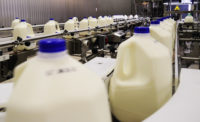Earlier this year, the European Union and Japan announced a trade agreement in principle that includes dairy market access to Japan. Europe is actively working to establish a trade deal with Mexico in which agriculture and dairy will no doubt be central components. New Zealand is renegotiating a trade agreement with China in large part to improve dairy access terms. New Zealand and Australia are pushing to implement a “Trans-Pacific Partnership light” with eight other countries including Mexico.
Those are just a few examples of the trade activity our main dairy export competitors are currently pursuing. They clearly illustrate a point: The United States needs a proactive trade policy agenda to remain globally competitive and defend and grow the U.S. dairy export market share. If we stand still, we will cede ground that the industry cannot afford to lose.
Trade agreements have been instrumental in U.S. dairy export growth and the subsequent benefits that growth has delivered to the U.S. economy. Since the mid-1990s, the United States went from exporting the equivalent of 4-5% of annual U.S. milk production to 14-15%. U.S. dairy export value went from less than $1 billion annually in the 1990s to an average of more than $5.5 billion over the last five years.
The increase in U.S. dairy exports since 2004 increased farmers’ milk prices by an average of $1.25 per hundredweight, adding roughly $36 billion to farm milk sales.
U.S. dairy exports support up to 100,000 jobs, from dairy farmers and processors to companies supplying inputs and services across the supply chain, covering every state in the union.
NAFTA a key
A proactive trade policy agenda is necessary to defend and advance those gains. It starts with the modernization of the North American Free Trade Agreement (NAFTA).
NAFTA is undisputedly the U.S. dairy industry’s most important trade deal and must be preserved and improved. Mexico is irreplaceable as a U.S. dairy customer.
In 2016, U.S. suppliers shipped $1.2 billion in dairy products to Mexico, up from $181 million in 1994, the first year of NAFTA implementation. The country accounted for more than one-quarter of U.S. dairy export value last year and is far and away the largest U.S. buyer of milk powder and cheese. The United States routinely controls a greater-than 70% share of Mexico’s sizable dairy import market.
Hard work by U.S. dairy processors and close cooperation between the U.S. and Mexican dairy industries fostered demand growth and U.S. shipments to Mexico, but we could not have achieved such success without the enormous trade liberalization benefits delivered by NAFTA.
Now, conceivably, all three of our major competitors could gain improved access to the Mexican market in the coming years. That is what makes NAFTA absolutely essential for our industry: It currently provides U.S. exporters with uniquely preferential access to the Mexican dairy market and, looking forward, is the vehicle the United States will need to ensure that we remain competitive.
Beyond Mexico
NAFTA is of course a three-way deal, and its renegotiation offers the best opportunity for the United States to address troublesome dairy issues with Canada — from omissions in the original agreement (e.g., Canada’s exorbitant dairy tariffs) to the nation’s habitual use of policy tools to distort trade. The latter again came to the fore earlier this year with Canada’s Class 6 and 7 milk pricing schemes.
NAFTA also allows us to tackle general issues that threaten U.S. competitiveness. I cannot overstate the urgency and importance of negotiating NAFTA language that addresses the EU’s global attempt to win further acceptance of its unfair geographical indications (GI) system. The EU continues to seek to monopolize certain common cheese names by imposing its GI regime on other nations, effectively erecting de facto barriers to trade and competition.
More broadly, the competitive benefits achieved through deals like NAFTA need to be repeated in other nations. We urgently need a proactive trade policy agenda with key agriculture-importing countries the world over, including critical Asian markets, such as Japan and Vietnam, to keep pace in regions of strong dairy demand growth.
This is not a Democratic or Republican issue. And it applies no matter who is in the White House. We need to continue voicing messages about the positive impact of dairy trade on businesses and communities. We need to have a trade policy agenda that clearly advances U.S. agriculture and that demonstrates both political parties clearly see the benefits of well-negotiated agreements. U.S. dairy export competitiveness is at stake.



